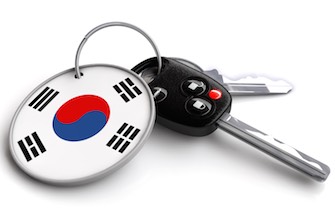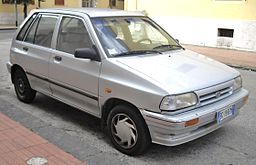 Americans love cars but despite all of the nostalgia our country has for the former strength of Motor City and Detroit’s auto industry, it’s becoming increasingly clear that we’re not too picky about who actually makes our vehicles. “Buy American” might be a nice slogan but in 2014, only four American models wound up on the year’s ten top-selling vehicles according to Edmunds.com. One of those, the Ram 1500, is made by an American-based subsidiary of London-based Fiat Chrysler Automobiles (FCAU:US), to which an American-made purist might take exception.
Americans love cars but despite all of the nostalgia our country has for the former strength of Motor City and Detroit’s auto industry, it’s becoming increasingly clear that we’re not too picky about who actually makes our vehicles. “Buy American” might be a nice slogan but in 2014, only four American models wound up on the year’s ten top-selling vehicles according to Edmunds.com. One of those, the Ram 1500, is made by an American-based subsidiary of London-based Fiat Chrysler Automobiles (FCAU:US), to which an American-made purist might take exception.
Recently, we took a look at the history of Japanese automobiles in the American market. We found that American consumers will be more receptive to a cost-effective product than patriotism even when making major purchase decisions. Both Toyota and Nissan were able to overcome the shoddy workmanship of their early vehicles and earn greater market shares thanks to their advantages in fuel efficiency during the 1973 OPEC oil crisis. Whereas American companies produced four of the Top 10 selling 2014 vehicles, Japanese companies took the other six spots; Edmunds.com reports that the Toyota Camry, third overall among American car sales, was the best-selling Japanese model with 389,091 units sold that year.
Yet Japan is not the only economic sector in Asia that has been eking out a strong niche in the global automotive sector. The 2015 Global Automotive Executive Survey released by global auditing firm KPMG reports that the Hyundai/Kia group of South Korea is the auto manufacturing business whose market share was most expected to increase by auto executives. As of 2015, the report shows that Hyundai/Kia holds the fifth-overall ranking for mass market vehicle production. The story of South Korean car makers entering the U.S. market and Korean automobiles on American roadways follows a familiar script. Consumer perceptions give way to a recognition of quality improvements and lower price tags.
[Companies-1]
Koreans Enter the American Auto Market in the 1980s
Japanese automakers Nissan and Toyota both had their first American sales in the late 1950s, putting them a few decades behind their American counterparts in Detroit. South Korean car manufacturers, however, didn’t get their first taste of U.S. sales until the 1980s, putting them behind America’s Big Three by the better part of a century.
The first of the Korean car manufacturers to offer its product to American consumers was Hyundai (KRX:005380), which began offering the Excel in 1986. Hyundai had engaged in a five-year apprenticeship period with the Ford Motor Company between 1968 and 1973 to develop the company’s earliest car models for domestic release. Ahead of the 1986 release of the Excel, the corporation established Hyundai Motor America in Garden Grove, CA, employing 227 people at Hyundai’s U.S. headquarters.
Initially, the Hyundai Excel looked like a great success having sold 168,882 units in its first year, a record for first-year sales of an import car distributor. The following year saw increased sales of 263,610 units, finding an consumer base made up of car buyers on a budget who couldn’t afford the many luxury options being released by American and Japanese automakers in the late 1980s.
Soon, however, quality issues with the Excel began to emerge which sent many consumers running from the Hyundai brand. The cheap construction of this model resulted in a car which became difficult to steer after a year’s worth of driving and had switches that snapped off when operated; some drivers even reported leakage of green heater core liquid. After those first few years of healthy sales figures, the brand perception of Hyundai was relegated to those lowest levels reserved for complete automotive failures like the Yugo or Pinto. The company’s fortunes fell so far during the last decade of the 20th century that by 1998, Hyundai enjoyed a U.S. market share of a paltry 0.4 percent.
The first automobile manufactured by Kia (KRX:000270) and available to American consumers wouldn’t come until 1987 after its own apprenticeship with Ford began in 1986. Late in 1987, Kia began exporting its Pride model to North America and selling it under the Ford Festiva brand. Kia would end up exporting approximately 350,000 units of the Ford Festiva and later revamp the car’s design for a 1993 re-release as the Ford Aspire.
Quality control issues didn’t diminish Kia’s progress the way they did for Hyundai but global financial turbulence struck a severe blow to the company’s prospects in the mid- to late-1990s. The 1997 Asian financial crisis saw extreme currency devaluations for many countries in the region; at one point between February and March 1998, about 10,000 South Koreans were being laid off every day. Kia, having already sold 100,000 cars in the United States, became insolvent and was sold at auction in October 1998 to Hyundai which beat out three other bidders, including Ford.
[Companies-3]
Hyundai and Kia Strive Together for Automotive Success in America
Subsequent to the Hyundai/Kia merger, HK Logistics America was formed in 2003 to handle logistics for both companies. The two companies would still operate as competitors in the American market, however, with Kia selling stylish cars for younger consumers while Hyundai worked to capture the sector of older drivers. Kia particularly saw a quick turnaround after selling 134,594 vehicles in 1999 to become the fifth-best selling import brand in America.
The decade of the 2000s saw both of these companies increase their manufacturing footprint in the United States. In April 2002, Hyundai broke ground on its first automobile assembly plant situated in the U.S., located in Montgomery, AL. The $1.7-billion facility opened in May 2005 and began its service by starting production of the 2006 Hyundai Sonata. The facility includes a stamping shop, a welding shop, a paint shop, two engine shops and a general assembly area containing more than 7,000 feet of conveyors. In 2012, more than 361,000 vehicles were finished at this facility. As of May 2014, more than 3,000 people were employed at the plant.
Kia’s first American production plant, Kia Motors Manufacturing Georgia (KMMG), was announced in March 2006. More than 2,200 acres would serve as the home for the Kia factory in West Point, GA; ground was broken on the plant in October 2006. The plant didn’t produce it’s 50,000th vehicle until April 2010 but it broke the 100,000-vehicle mark by September of that year, a scant five months later. In 2012, Kia was recognized by Georgia Governor Nathan Deal as the state’s Large Manufacturer of the Year; by the beginning of that year, KMMG was capable of outputting 360,000 vehicles in a year using parts sourced from the U.S. and around the globe. The factory directly employs some 3,000 people and Kia boasts total employment levels of 7,500 at regional suppliers.
Of course, “Made in America” doesn’t exactly mean American-made. Both Kia and Hyundai have taken pains in their marketing campaigns to ensure that American consumers know that their vehicles are assembled in this country. As of 2015, neither of these two South Korean auto manufacturers produced a single vehicle which was at least 50 percent constructed from parts sourced in the U.S., according to the most recent American Automobile Labeling Act reports published by the National Highway Traffic Safety Administration (NHTSA). The Hyundai Tucson, named for an American city, only incorporates one percent of American auto parts, sources both its engine and transmission from South Korea and is assembled in that country as well. Kia’s Soul and Sportage models have similar manufacturing profiles. Hyundai Motor America’s former CEO John Krafcik touted the American-based production of best-selling models like the Elantra, Sonata and the Sante Fe in 2010 but according to the most recent NHTSA data, every 2015 version of these models is at least half Korean-made. Only four percent of the 2015 Santa Fe is made from American parts; the engine, transmission and its assembly are all Korean.
Yet consumers will still flock to a product that gets the job done and won’t cost them a lot of money. Despite earlier qualms about quality issues in the cars produced by the Hyundai/Kia group, cheap value models like the Hyundai Accent and the Kia Spectra saw strong sales levels during 2008. Between 1998 and 2008, Kia tripled its American auto sales, while Hyundai was able to manage that same feat between 1999 and 2008. In 2011, Hyundai enjoyed sales growth of 23 percent over the previous year and Kia sales jumped 28 percent in that time, record sales jumps for both companies.
Some of the expected increase in market share for Hyundai/Kia in the coming years may be attributable to the fact that Kia, typically considered a budget brand, has been starting to make moves into the luxury sedan market. In 2013, Kia offered the Optima SX Limited with Nappa leather front seats with heating and cooling functions, heated rear passenger seats and a dash-mounted navigation system; a hybrid version of this model topped out its fuel efficiency at 40 miles per gallon. The more recent Kia K900 luxury sedan saw very discouraging sales levels, however, with only 1,050 being sold in 2014 during the car’s first six months of sales.
Hyundai and Kia are not long to be the only South Korean auto manufacturers selling cars to Americans. Ssangyong Motor Co. (KRX:003620) is expected to begin selling automobiles in America within the next two years. According to reports of trademark application filings to the U.S. Patent and Trademark Office, we’re likely to see these vehicles being sold under brand names like Luvent or Tivoli. It has been pointed out that Ssangyong has filed for other U.S. trademarks in the past that have never been seen on cars in America but it’s clear that South Korean auto has become a meaningful force in the industry far removed from its early struggles of the late-1980s and 1990s.

![[IPWatchdog Logo]](https://ipwatchdog.com/wp-content/themes/IPWatchdog%20-%202023/assets/images/temp/logo-small@2x.png)



![[Advertisement]](https://ipwatchdog.com/wp-content/uploads/2024/03/IP-Copilot-Apr-16-2024-sidebar-700x500-scaled-1.jpeg)
![[Advertisement]](https://ipwatchdog.com/wp-content/uploads/2024/04/Patent-Litigation-Masters-2024-sidebar-early-bird-ends-Apr-21-last-chance-700x500-1.jpg)

![[Advertisement]](https://ipwatchdog.com/wp-content/uploads/2021/12/WEBINAR-336-x-280-px.png)
![[Advertisement]](https://ipwatchdog.com/wp-content/uploads/2021/12/2021-Patent-Practice-on-Demand-recorded-Feb-2021-336-x-280.jpg)
![[Advertisement]](https://ipwatchdog.com/wp-content/uploads/2021/12/Ad-4-The-Invent-Patent-System™.png)







Join the Discussion
No comments yet.